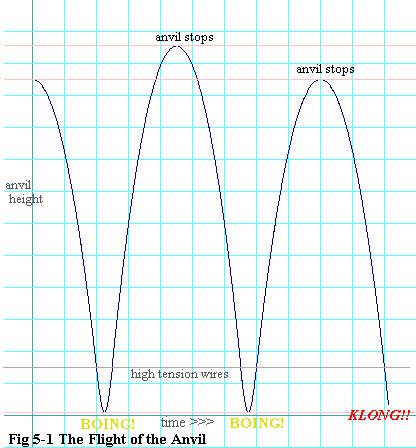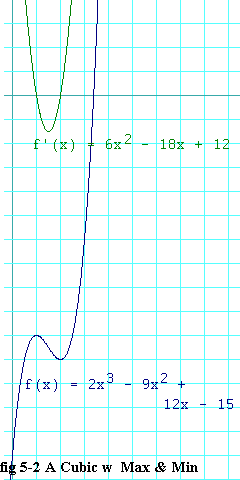

Since you began your study of calculus, have you ever thought to yourself, "If only I were a genius, this stuff would be a snap." Well I'd like to introduce you to a fellow who is a genius. He undoubtably learned calculus before he was out of puppy-hood.

|
My apologies to Chuck Jones, the creator of Wile E. Coyote. If he or his copyright holders object to my usage of the character here, please contact me and I will remove it. The name, Wile E. Coyote, and the image of him are copyrighted trademarks of Warner Brothers, Inc. |
There is something about Mr. Coyote, though, that is far more admirable than his genius. He never gives up, no matter how miserably and how many times he fails. If you emulate that one trait, you will end up learning this material. And that is the first lesson you can learn from him.
Here is another. Wile E. Coyote stands on a cornice at the rim of a canyon, holding an Acme anvil. Far below, a bridge spans the canyon. On it there is a pile of birdseed. The Roadrunner zips along, fit to cross the bridge in the blink of an eye. But he halts suddenly at the bird seed and begins pecking. This is Wile E's cue. He drops the anvil. It plummets down toward the unsuspecting Roadrunner, who, while the anvil is still falling toward him, has finished his snack. The Roadrunner zips off across the bridge and disappears in the distance. The anvil drops through the roadway, right where the Roadrunner was, leaving an anvil-shaped hole. It continues to drop until it encounters some high-tension electrical wires that run under the bridge. The wires stretch under the impact until the anvil is just inches above the ground. Then they spring back, catapulting the anvil straight up. It flies back up through the anvil-shaped hole in the bridge. It flies up past the cornice where Mr. Coyote still stands. It flies high above Mr. Coyote's head. Finally it runs out of steam and begins falling back down. This fact is not lost on Mr. Coyote, who now shields his head, for experience has taught him of the attractive power his head has for heavy objects. But to his joyous surprise, the anvil misses him. Instead it falls through the cornice, which cracks as a result and becomes free of the canyon rim.
I think you know the rest of this story. The cornice drops out from under Coyote. Coyote (still happy over avoiding the all too familiar sensation of anvil versus carnivore skull) somehow ends up traveling downward beneath the falling cornice. Coyote leaves a coyote-shaped hole in bridge, which soon becomes a cornice-shaped hole. The anvil bounces again on the wires. Coyote is not so lucky. The wires try to mitigate his fall, but unfortunately he ends up wedged between the wires and the massive cornice. But not for long. The squeeze has the effect of causing Coyote to arrive at the canyon floor in slices. By some miracle he is able to pull himself together from this mishap just in time to be struck on the head by a falling anvil. And of course, in his daze, he is unaware that he now stands in the rapidly expanding shadow of a falling cornice.
What on earth, you are probably wondering, does any of this have to do with calculus? Well, I'd like you to focus your attention on the flight of the anvil. At what times other than before Coyote releases it and after it arrives on top of his head is the anvil at a standstill? When the anvil reaches the wires the first time, the wires stretch, slowing the anvil down. According to the story, just inches from the ground the anvil turns around and begins traveling up instead of down. Then it flies up, finally losing steam high in the air, and it turns around and drops back down. At each of those turn-around moments (and at the other two times it turns around), isn't the anvil stopped for an instant? In fact, isn't it impossible to reverse direction without stopping for just an instant?
We call such moments when the anvil is stopped momentarily in flight, stationary points or critical points.
 And notice another thing. At the moment the anvil turned around on the
wires -- just inches above the ground -- wasn't it as low as it was
going to go (at least on this leg of its flight)? And at the moment
it turned around high over Coyote's head, wasn't it as high as it
was going to go? And when you walk down a wooded path and finally get
tired and stop, then turn around and walk back, isn't that as far as
you are going to go into the woods (at least on that walk)?
And notice another thing. At the moment the anvil turned around on the
wires -- just inches above the ground -- wasn't it as low as it was
going to go (at least on this leg of its flight)? And at the moment
it turned around high over Coyote's head, wasn't it as high as it
was going to go? And when you walk down a wooded path and finally get
tired and stop, then turn around and walk back, isn't that as far as
you are going to go into the woods (at least on that walk)?
There are two points here. One is that to reverse direction, you must stop for at least an instant. The other is that when you do reverse direction, you are as far in one direction as you are going to get -- at least until you've turned around again. And that is the essence of what this section is about.
So in the case of the anvil, you can look for when it is as high as it will go and as low as it will go by looking for the moments at which it is stopped. And stopped means its speed is zero. And isn't speed the derivative of its position with respect to time? So to find the moments that the anvil is at its extreme positions, we look for the moments at which the derivative of position is exactly zero. And that is the definition of a stationary or critical point (the two words are synonymous). We have a stationary or critical point of a function whenever its first derivative is zero.
At stationary (or critical) points is where we look for a function to attain an extreme. That is the function is likely to be momentarily as big as it will get (locally) or as small as it will get (locally). In other words, it is likely to reach either a local maximum or a local minimum.
Note: The word you may have already encountered in class, extrema, is nothing more than the Latin plural of the word, extreme. Likewise maxima and minima are the Latin plurals or maximum and minimum respectively).
Let's take a simple example of a problem we can solve using this method.
Consider the function,
Let's try a harder example. Suppose we have
 You should note, first,
that this f(x) gets as large as you like if you pick x
large enough and it gets as small as you like (that is as negative as
you like) if you pick x negative enough. So there is no global
maximum or minimum. But, as we shall see, there is local a maximum
and a local minimum.
You should note, first,
that this f(x) gets as large as you like if you pick x
large enough and it gets as small as you like (that is as negative as
you like) if you pick x negative enough. So there is no global
maximum or minimum. But, as we shall see, there is local a maximum
and a local minimum.
But what do we mean by a local maximum or minimum? Well look back at the flight of the anvil graph in figure 5-1. The second "hump" is not as high as the first, so the second hump cannot possibly be a global maximum. But it is a local maximum. Why? At that point the anvil is higher than it is either immediately before of immediately after the hump.
Of course that wording is not rigorous enough to write on an exam. So
here is the rigorous wording that means the same thing. If a function,
f(x), has a local maximum at
You can come up with a similar definition for local minimums, and that is an exercise I'd like you to try.
Let's get back to
You should by now have observed that both the local maximum and local minimum of the blue trace occur at the same x-values as where the green trace (which is the derivative of the blue trace) crosses the x axis. Not only that, if you were especially observant, you would have noticed that the local maximum of the blue trace occurs where the green trace crosses the x axis going down (as you scan left to right), and the local minimum occurs where the green trace crosses the x axis going up. In fact, this is how you can tell local maximums from minimums without having to make a graph.
But how can you tell whether the derivative is crossing going up or down without having to graph it? Simple. Find the derivative of the derivative. Where the derivative is sloping down, the derivative of the derivative will be negative. Where the derivative is sloping up, the derivative of the derivative will be positive.
The derivative of a derivative is something that comes up all the time in calculus. So naturally, it has a name. The derivative of the derivative of a function, f(x) is called the second derivative of f(x), and is indicated by the symbol, f"(x).
In this case we have the derivative given by
Now observe that if we take out two stationary points,
This rule on how to distinguish local maximums from local minimums
 is useful
enough that you should memorize it. But, as always, it is even more useful
to know why it works. Let's go back to Mr. Coyote's anvil. Here
again is the graph of that. Will you agree that I should call up
the positive direction and call down the negative
direction, as is illustrated on the graph? So when the anvil is
traveling up, its velocity is positive and when it is traveling down, its
velocity is negative. And remember that velocity is the derivative of
the blue trace in this graph (figure 5-1).
is useful
enough that you should memorize it. But, as always, it is even more useful
to know why it works. Let's go back to Mr. Coyote's anvil. Here
again is the graph of that. Will you agree that I should call up
the positive direction and call down the negative
direction, as is illustrated on the graph? So when the anvil is
traveling up, its velocity is positive and when it is traveling down, its
velocity is negative. And remember that velocity is the derivative of
the blue trace in this graph (figure 5-1).
Remember, the anvil's velocity is the derivative of its position.
So the anvil starts out with negative, that is to say a downward
velocity. Let's say that when it reaches the wire, the anvil is going
100 meters per second downward, or in other words,
In fact, the whole time the anvil is in contact with the wires, its velocity is becoming progressively greater (at first by becoming less negative, and then by becoming more positive). In other words, the velocity's change is positive throughout that time. But that is just another way of saying the velocity's derivative is positive. And the velocity's derivative is the same as the second derivative of the anvil's position.
But if the anvil was moving down before it hits the wires and is moving up after it hits the wires, it must have been at its minimum height some time while it was in contact with the wires, that is during that same time when the derivative of its velocity (that is when the second derivative of the anvil's position) was positive
See if you can make a similar verbal analysis on the anvil's motion as it soars back up after springing from the wires, being slowed down as it goes by toon-gravity (whose physics is known but to animators). Describe what happens at the peak of the anvil's trajectory. How does this confirm the rule we have for maximums?
1) Local maximums and minimums of a funtion, f(x), often (but not always) occur at stationary points where the function's derivative, f'(x), is zero.
2) You can determine whether a stationary point is a maximum or a minimum by using the following rule: If the second derivative of f(x), that is, f"(x) is negative at the stationary point, then that stationary point is a maximum. If the second derivative is positive at the stationary point, then the stationary point is a minimum. We shall cover the case of the second derivative being itself zero at the stationary point in the next section.
3) You can solve for the x-values of stationary points by setting the derivative to zero and finding what x-values satisfy the resulting equation.
4) You can find the y-values of the stationary points by substituting the x-values you got from summary-point 3) into f(x).
5) This stuff will be on the exam.
Note: See if you can do these exercises without graphing the functions first. Do the necessary analysis first, then draw the graph, if necessary, to check your work.
1a) Let
1b) Find f"(x) for the the above function and use it to discover whether the stationary point is a maximum or a minimum.
2a) Let
2b) Find f"(x) for the above function and use it to discover the nature of the stationary points from 2a (are they maximums, minimums, or a mixed bag, and if they are mixed, which is which?)
3a) Let
1
f(x) =
x2 - 2x + 2
Use the method demonstrated in this section to find its stationary point.
Hint: You will have to apply
the quotient rule, or if you're clever,
you can get by using
the chain rule.
3b) Find f"(x) and use it to discover whether the stationary point is a maximum or minimum. Hint: You will have to apply the quotient rule again to do this.
4) Three sides of a window frame form three of the sides of a rectangle. The fourth side is a semicircle. The perimeter of this shape is fixed at 3 meters. Find the dimensions that maximize the area enclosed. Also determine what the maximized area is.
5) Find the point(s) on the curve,
6) If a triangle has sides of length a, b,
and c, then Hero's Formula enables you to find
the area of the triangle without knowing its height. The formula
says to set
a + b + c
s =
Then the area, A, of the triangle is given by
2
______________________
A = Ös(s - a)(s - b)(s - c)
To learn more about how Hero's Formula comes about,
Move on to 5.2 Squigglies, Wormtails, and Pointed Little Heads
email me at hahn@netsrq.com
Definition of Open Interval:
This is an interval that does not contain its
endpoints. "All x such that
We know that any maximums and minimums of f(x) can only occur at x-values where f'(x) is zero. Such points are called stationary points of f(x). In this example the we have
f'(x) = 6x2 - 18x + 12 eq. 5.0a-1which was given in the graph. We know that
6x2 - 18x + 12 = 0 eq. 5.0a-2Do you see why we have to solve the 5.0a-2? (And did you get
This is the start of the approach you take to solving all maximum and minimum problems. That is, whatever function you need to know the maximum or minimum of, first find the stationary points by solving for where that function's derivative is zero.
Note well that not all maximum or minimum points occur at stationary points and not every stationary point is a maximum or minimum. We will discuss the exceptions later on at length. But stationary points are what you should look for first in this type of problem.
We can see visually on the graph that
So what are the actual coordinates local maximum and local minimum of
Make sure you know how we arrived at these answers. You may have to review this box several times.
Just a post script here. Yes I do know that the proper plurals of "maximum" and "minimum" are "maxima" and "minima". But it seemed to me that the non-Latin-speakers among you would find the terminology I did use more intuitive. Your textbook, however, is likely to use the Latin-style plurals.